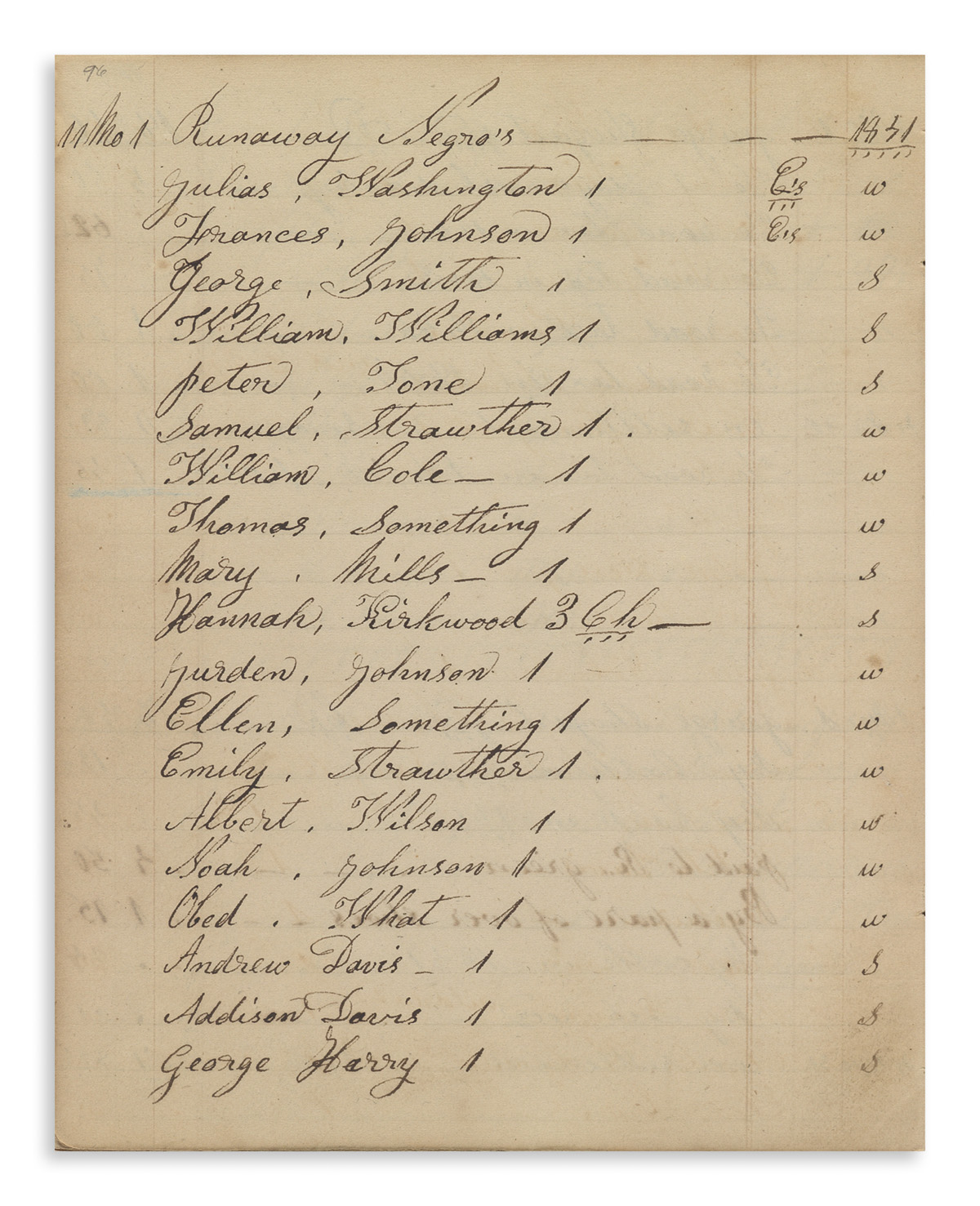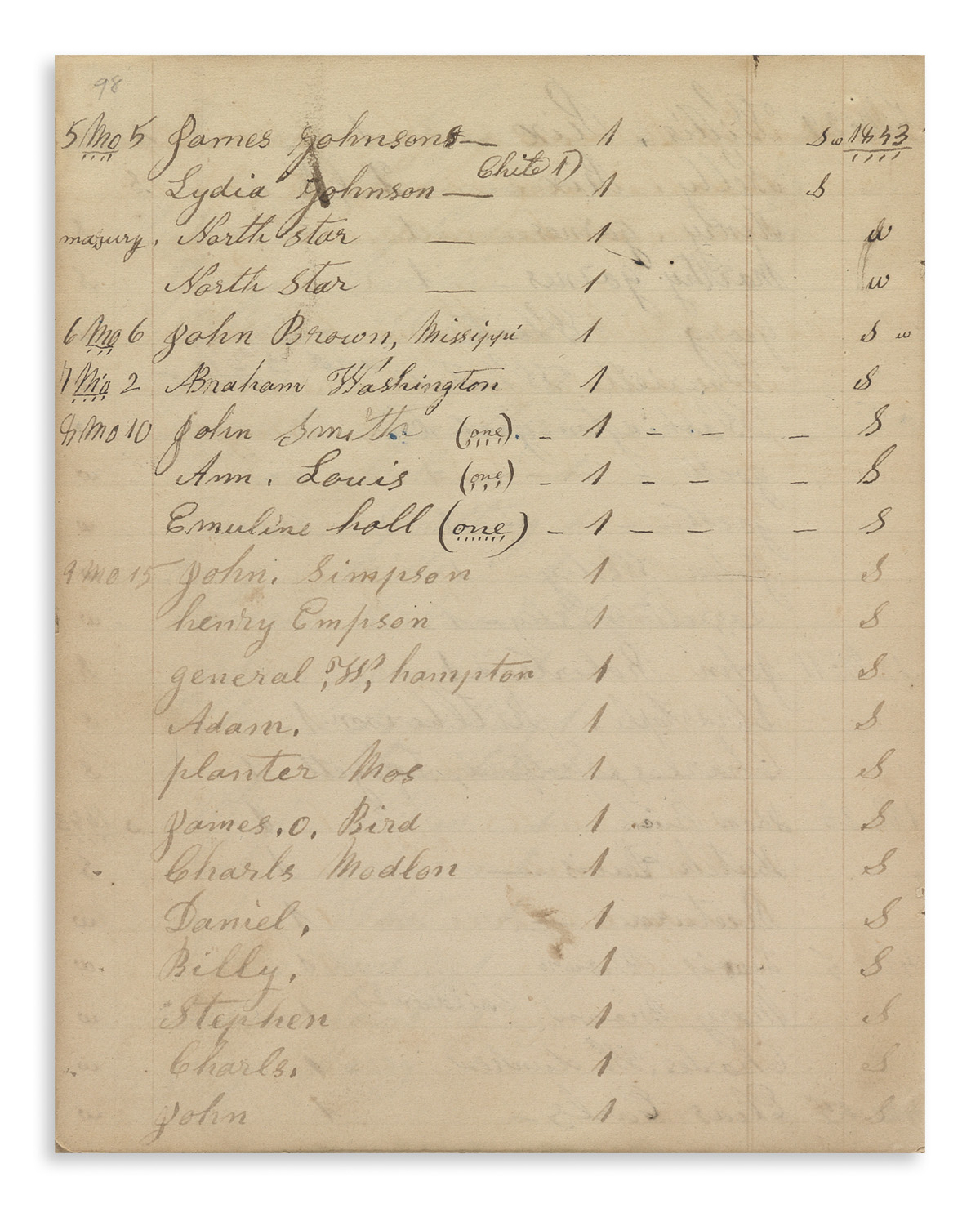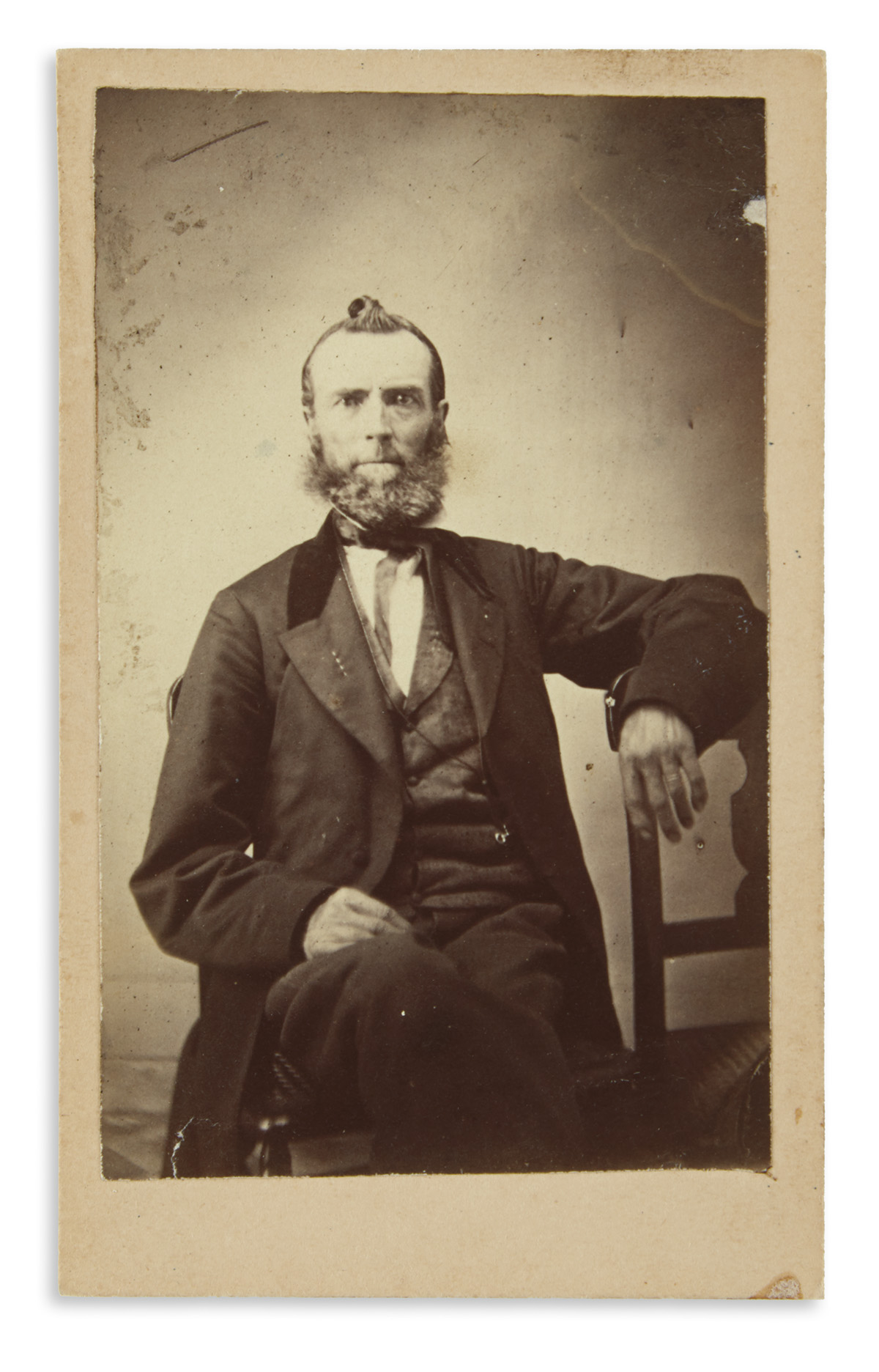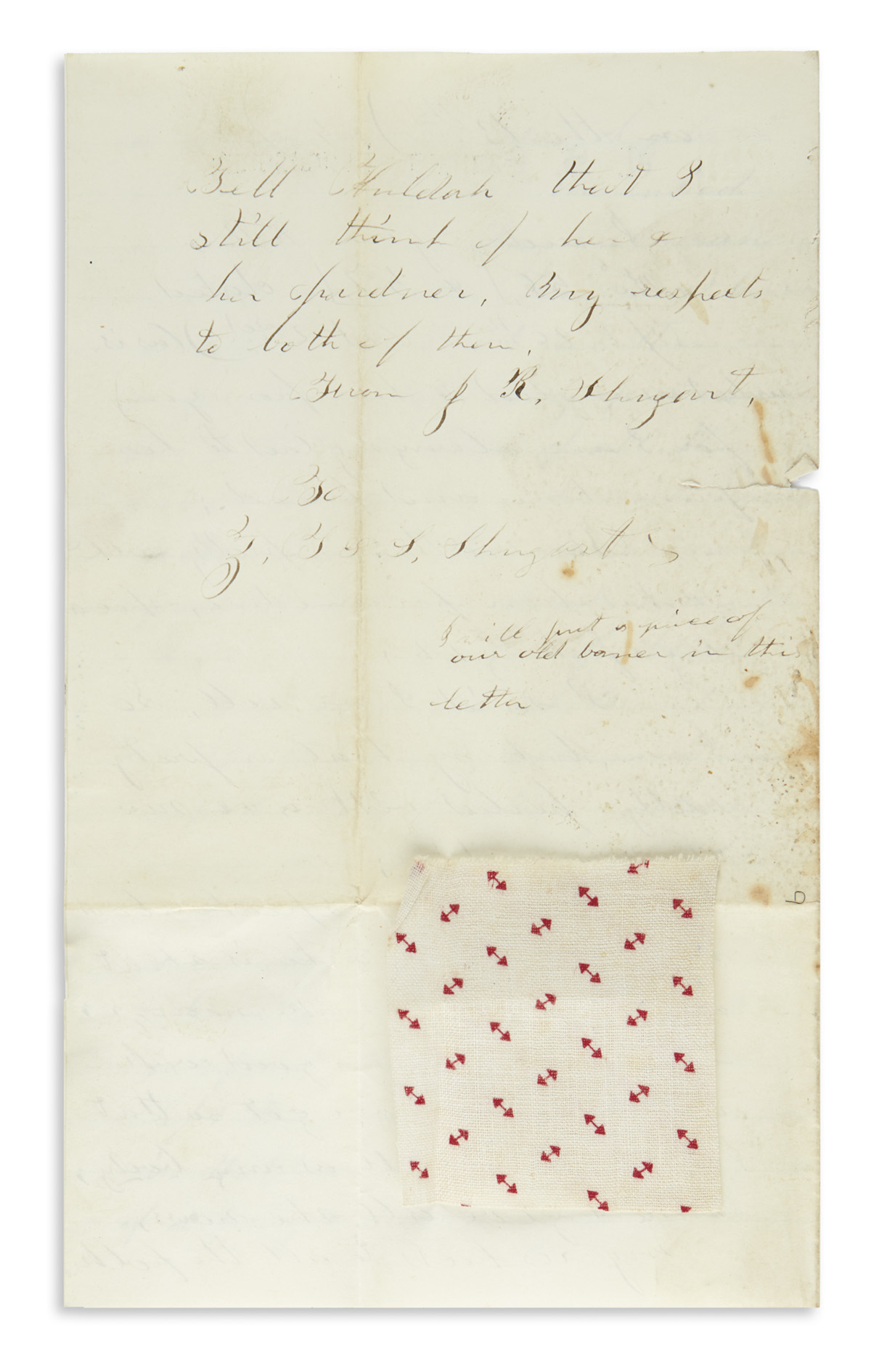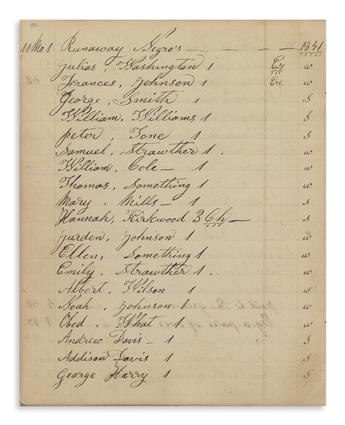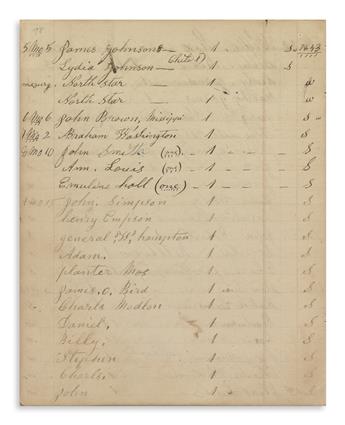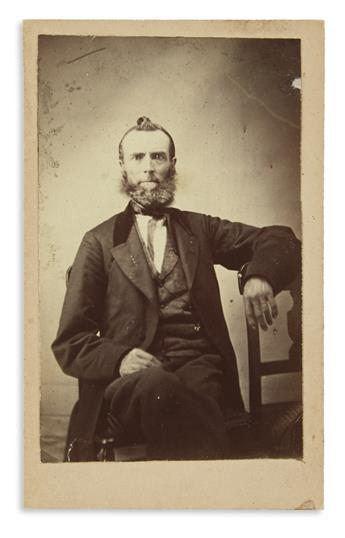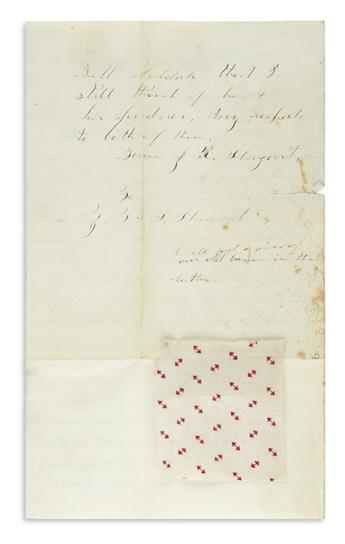Sale 2517 - Lot 205
Price Realized: $ 80,000
Price Realized: $ 100,000
?Final Price Realized includes Buyer’s Premium added to Hammer Price
Estimate: $ 30,000 - $ 40,000
(SLAVERY AND ABOLITION.) Shugart family papers including documentation on the Underground Railroad. 63 items in one box, 0.4 linear feet; various sizes and conditions. Account book: 105 manuscript pages, 4to, original 1/4 sheep, moderate wear, several pages loose, a few apparently excised prior to numbering. Vp, 1838-81 and undated
Additional Details
Zachariah Taylor Shugart (1805-1881) was born a Quaker in North Carolina, and spent most of his early years in Indiana before settling in Cass County, Michigan in 1840; he moved on to Iowa in 1853. Shugart was a known active participant in the Underground Railroad circa 1840 to 1851, as cited in "History of Tama County, Iowa" page 1053 and in Snodgrass, "The Underground Railroad: An Encyclopedia," page 483-4. A dramatic account of one 1847 case known as the "Kentucky Raid" is told in the 1882 "History of Cass County, Michigan," pages 109-115.
The central item in this lot is an account book kept by Shugart from 1838 to 1852 which details his involvement in the Underground Railroad. Dated in the Quaker style, it begins while Shugart was still in Indiana, but most of the entries date from his time in Michigan. A section from pages 96 to 101 and 104 is headed "Runaway Negroes." It runs to 107 entries from 1841 to 1843 and then undated. Many of the early entries give complete names, tending toward increasing anonymity as the list went on, ranging from "Samuel Strawther" to "Ellen Something" to "Daniel" to "Something." Among the more evocative names given are "North Star" and "General W. Hampton." Several entries include families, such as "Nelly Rix, 2 ch" or "Patience, 5 children." Each entry is marked either "s" or "w"; we can only guess that these may have denoted the next destination on the route.
Numerous other entries suggest connections to Shugart's Railroad activities. Stephen Bogue, Shugart's main local collaborator in Cass County, appears on pages 16-17, 90-91 and 103 with accounts dated 1844 and 1848. The 1850 census shows a John Watkins living with the Shugarts, described as a mulatto shoemaker aged 24 and born in Virginia. This is likely the J.D. Watkins whose account fills pages 48-49 and 60-65. Watkins paid his board from 1850 to 1852 by making and repairing shoes for local townspeople; a note on page 104 reads "Moved J.D. Watkins shop, 7th mo 1st 1851." On page 88 is a long listing of legal expenses in which Shugart attended court, obtained subpoenas for witnesses, and paid lawyers from November 1850 to June 1851. These expenses likely relate to his prosecution by Kentucky slaveholders for his central role in thwarting the 1847 Kentucky raid, in which he had actively resisted a group of kidnappers and helped dozens of escaped slaves on their way to Canada. Josiah Osborn, another key figure who helped thwart the Kentucky Raid, is mentioned on page 100.
The other highlight of the collection is a group of 7 letters to Zachariah Shugart from his son Joseph R. Shugart (1842-1864), then serving as a soldier in the 28th Iowa Infantry. Most notable is a 27 May 1863 letter which describes the Battle of Champion's Hill, where he was wounded. The rebels "turned on us with about 5 to our one & were about to outflank us & surround us, so we had to retreat in hast. . . . The 28th Iowa & 46 Indiana broke & run as if the devil was after them. We retreated across an open field about 50 or 60 rodds. As I was on retreat I got shot with a rifle ball through the lower part of the mussle of my arm. . . . That battle is called the Battle of Champion Hills & it is said to be the hardest battle ever fought in America for the time it lasted." His last letter, dated 17 October 1864, complains of the 43rd Battalion of Virginia Cavalry, better known as Mosby's Raiders: "Colonel Mosbey has a band of gorillas of about 500, they are all mounted on good horses. They will make a dash upon our train and burn & capture as much as they can & if they catch any of our men, they will rob them of all they have & strip them & sometimes kill them." Enclosed with the letter is a swatch of fabric, described as "a piece of our old banner." Shugart would be killed just two days later at the Battle of Cedar Creek; the original newspaper clipping listing him among the dead is included.
Also included are a pocket diary kept by Zachariah Shugart in January-September 1867 while running a drug store in Belle Plaine, Iowa near Cedar Rapids. On 7 January he noted "about 4 hundred soldiers on the cars bound for the Indian country." His 10-page bound travel narrative from September-October 1880 documents a trip from Belle Plaine to attend Quaker meetings. He notes with some bemusement "Preaching. Praying. Talking & much singing. Not much like the Quakers in Fox's day!" A large collection of photographs, 46 loose and 42 in an album, are mostly unidentified; many bear backmarks from Iowa photographers. Formats range from cartes-de-visite to cabinet cards to tintypes to one cased daguerreotype. One unmarked photograph can be identified as Zachariah Shugart, whose distinctive hairstyle and beard as seen in other photographs would never again be replicated until early 21st-century Brooklyn. Provenance: the account book bears an inscription stating that it was given in May 1881 by Zachariah Shugart's widow Susannah to her grandson Grant Overturf (1868-1936).
Taken as a whole, we don't know of any other Underground Railroad documents at auction that have approached the extent or detail of Zachariah Shugart's account book. Offered in the context of Shugart's other personal papers, its authenticity and power are beyond question.
The central item in this lot is an account book kept by Shugart from 1838 to 1852 which details his involvement in the Underground Railroad. Dated in the Quaker style, it begins while Shugart was still in Indiana, but most of the entries date from his time in Michigan. A section from pages 96 to 101 and 104 is headed "Runaway Negroes." It runs to 107 entries from 1841 to 1843 and then undated. Many of the early entries give complete names, tending toward increasing anonymity as the list went on, ranging from "Samuel Strawther" to "Ellen Something" to "Daniel" to "Something." Among the more evocative names given are "North Star" and "General W. Hampton." Several entries include families, such as "Nelly Rix, 2 ch" or "Patience, 5 children." Each entry is marked either "s" or "w"; we can only guess that these may have denoted the next destination on the route.
Numerous other entries suggest connections to Shugart's Railroad activities. Stephen Bogue, Shugart's main local collaborator in Cass County, appears on pages 16-17, 90-91 and 103 with accounts dated 1844 and 1848. The 1850 census shows a John Watkins living with the Shugarts, described as a mulatto shoemaker aged 24 and born in Virginia. This is likely the J.D. Watkins whose account fills pages 48-49 and 60-65. Watkins paid his board from 1850 to 1852 by making and repairing shoes for local townspeople; a note on page 104 reads "Moved J.D. Watkins shop, 7th mo 1st 1851." On page 88 is a long listing of legal expenses in which Shugart attended court, obtained subpoenas for witnesses, and paid lawyers from November 1850 to June 1851. These expenses likely relate to his prosecution by Kentucky slaveholders for his central role in thwarting the 1847 Kentucky raid, in which he had actively resisted a group of kidnappers and helped dozens of escaped slaves on their way to Canada. Josiah Osborn, another key figure who helped thwart the Kentucky Raid, is mentioned on page 100.
The other highlight of the collection is a group of 7 letters to Zachariah Shugart from his son Joseph R. Shugart (1842-1864), then serving as a soldier in the 28th Iowa Infantry. Most notable is a 27 May 1863 letter which describes the Battle of Champion's Hill, where he was wounded. The rebels "turned on us with about 5 to our one & were about to outflank us & surround us, so we had to retreat in hast. . . . The 28th Iowa & 46 Indiana broke & run as if the devil was after them. We retreated across an open field about 50 or 60 rodds. As I was on retreat I got shot with a rifle ball through the lower part of the mussle of my arm. . . . That battle is called the Battle of Champion Hills & it is said to be the hardest battle ever fought in America for the time it lasted." His last letter, dated 17 October 1864, complains of the 43rd Battalion of Virginia Cavalry, better known as Mosby's Raiders: "Colonel Mosbey has a band of gorillas of about 500, they are all mounted on good horses. They will make a dash upon our train and burn & capture as much as they can & if they catch any of our men, they will rob them of all they have & strip them & sometimes kill them." Enclosed with the letter is a swatch of fabric, described as "a piece of our old banner." Shugart would be killed just two days later at the Battle of Cedar Creek; the original newspaper clipping listing him among the dead is included.
Also included are a pocket diary kept by Zachariah Shugart in January-September 1867 while running a drug store in Belle Plaine, Iowa near Cedar Rapids. On 7 January he noted "about 4 hundred soldiers on the cars bound for the Indian country." His 10-page bound travel narrative from September-October 1880 documents a trip from Belle Plaine to attend Quaker meetings. He notes with some bemusement "Preaching. Praying. Talking & much singing. Not much like the Quakers in Fox's day!" A large collection of photographs, 46 loose and 42 in an album, are mostly unidentified; many bear backmarks from Iowa photographers. Formats range from cartes-de-visite to cabinet cards to tintypes to one cased daguerreotype. One unmarked photograph can be identified as Zachariah Shugart, whose distinctive hairstyle and beard as seen in other photographs would never again be replicated until early 21st-century Brooklyn. Provenance: the account book bears an inscription stating that it was given in May 1881 by Zachariah Shugart's widow Susannah to her grandson Grant Overturf (1868-1936).
Taken as a whole, we don't know of any other Underground Railroad documents at auction that have approached the extent or detail of Zachariah Shugart's account book. Offered in the context of Shugart's other personal papers, its authenticity and power are beyond question.
Exhibition Hours
Exhibition Hours
Aliquam vulputate ornare congue. Vestibulum maximus, libero in placerat faucibus, risus nisl molestie massa, ut maximus metus lectus vel lorem.



